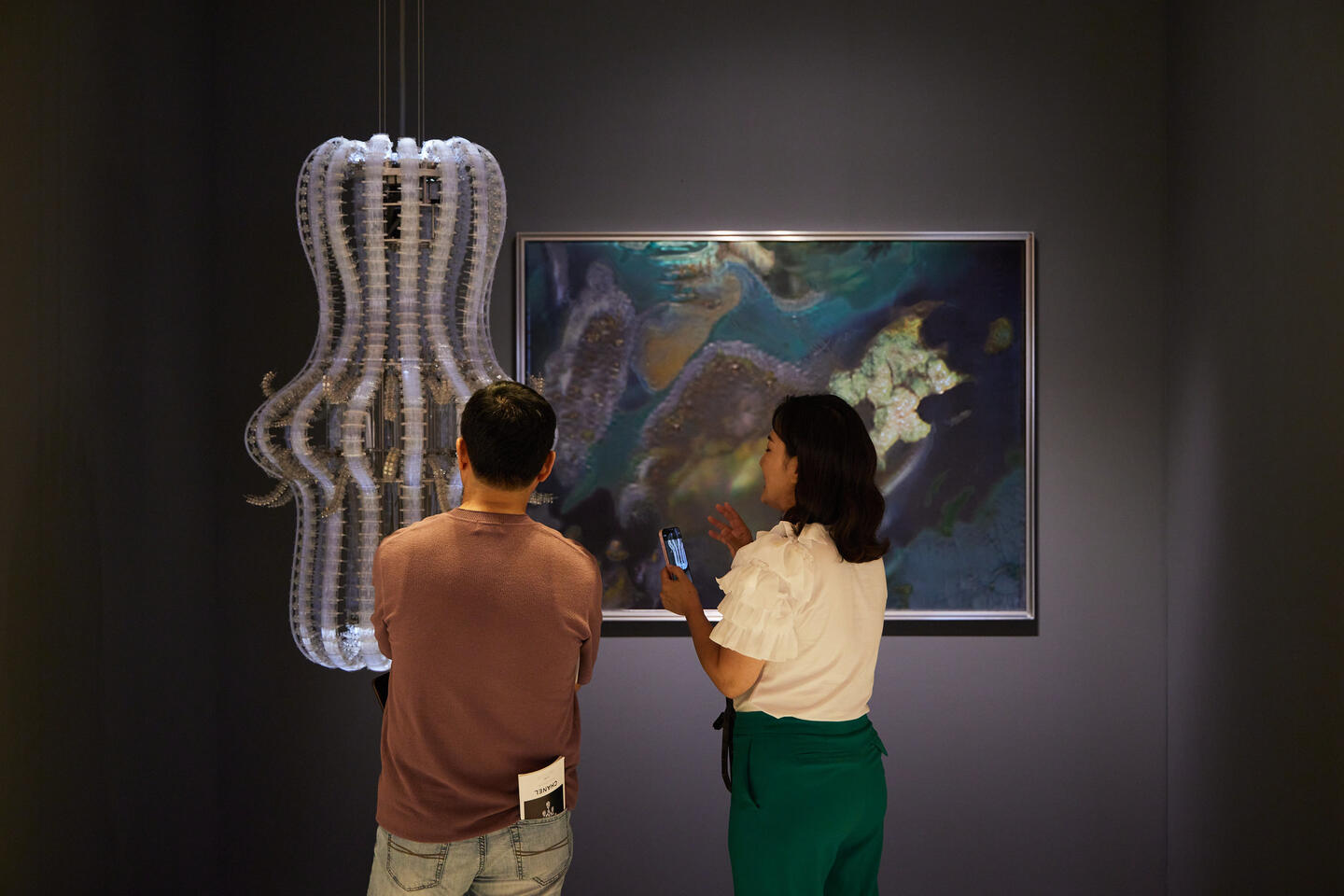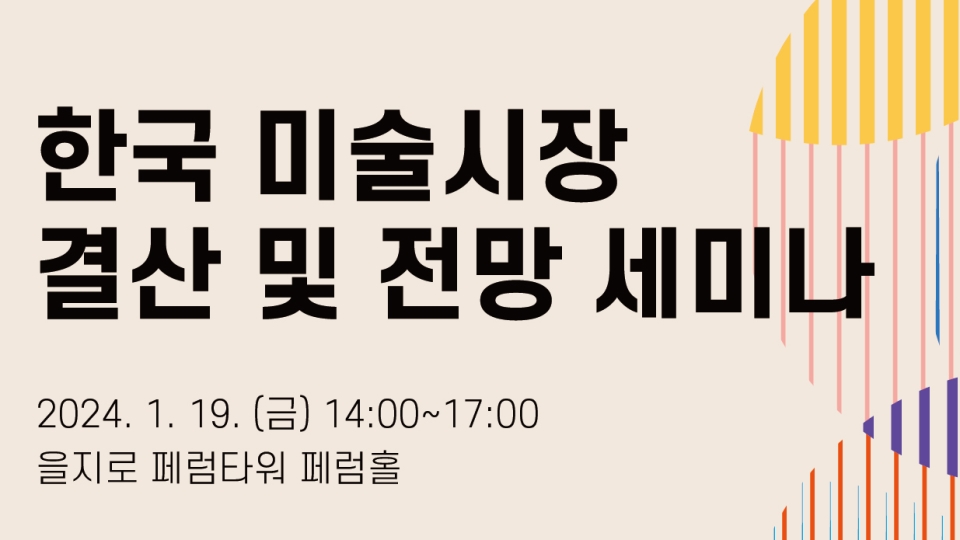This year’s Art Basel Hong Kong and Hong Kong Art Week showed the potential of the Asian art market with the participation of collectors and notable figures from different parts of Asia, including Korea, Japan, Thailand, Singapore, and Bangladesh, as well as Hong Kong and China.
 Kukje Gallery Gimhongsok, Solitude of Silences, 2017-2019. Courtesy of Art Basel.
Kukje Gallery Gimhongsok, Solitude of Silences, 2017-2019. Courtesy of Art Basel.Amid the international economic uncertainty, Art Basel Hong Kong, which took place from March 21 to 25, 2023, concluded with great success. The art world’s expectations of the fair were especially high this year, as it was the first time since 2019 that the event was held full-scale and in person.
Hong Kong has held a dominant position in the Asian art market for over a decade, but the challenges posed by frequent lockdowns caused by the COVID-19 pandemic and the implementation of China’s national security law, which came into effect in Hong Kong, have pushed the city into an unstable situation. With all the challenges, despite this year’s Art Basel Hong Kong’s strong sales results, several Korean media outlets observed that Hong Kong had lost its luster compared to the previous years before 2019.
A total of 177 galleries from 32 countries worldwide participated in this year’s art fair, an increase of 47 from the previous year. However, this number was a decrease compared to its largest edition, in which 250 galleries participated. In addition, a number of galleries and collectors from Europe and the US did not participate in this year’s edition, making the fair more Asian-centric.
 Art Basel Hong Kong 2023. Courtesy of Art Basel.
Art Basel Hong Kong 2023. Courtesy of Art Basel.The fair’s situation is undoubtedly related to the changed political situation in Hong Kong. According to The Guardian, the American media artist Patrick Amadon’s work No Rioters, which was scheduled to be screened on a billboard in a department store during Hong Kong Art Week, was taken down within a few days because the names of Hong Kong democracy supporters were mentioned in the artwork.
In addition, a film featuring Winnie-the-Pooh, often used to playfully taunt China’s President Xi Jinping, was removed from the Hong Kong Arts Centre’s cinema program a few days earlier. Moreover, some Korean reporters noted that they observed some suspicious agents listening in on their conversations with local museum officials.
Despite participants’ reports of healthy sales, Hong Kong’s art market faced many changes. In an interview with Newsis, a Korean news platform, one gallery said, “This year, it was definitely different from four years ago, when people had to stand in a long line that took more than 30 minutes to enter the fair, and the fair used to be so crowded that it was almost impossible to walk around.”
 Jason Haam. Artist Moka Lee. Courtesy of Art Basel.
Jason Haam. Artist Moka Lee. Courtesy of Art Basel.Unlike what several Korean reporters noted, international market experts observed that brisk sales and high attendance marked the fair throughout the week. Although the attendance of Western collectors decreased, the fair was full of energy with the participation of collectors from Korea, Japan, Thailand, Singapore, and Bangladesh, as well as those from Hong Kong and Mainland China.
In an interview with Artsy, an online art market platform, dealer and auctioneer Simone de Pury mentioned that the atmosphere at the Hong Kong fair was more energetic than before 2019, and everyone was overflowing with anticipation. Many reported that Hong Kong Art Week was filled with the enthusiasm of young collectors in their 30s and 40s. The general opinion was that these young collectors showed great interest not only in the Art Basel fair but also in various art scenes happening in the Hong Kong art world.
Evan Chow, deputy chairman of the Hong Kong Arts Centre, told Artsy that “the collectors ambling around Art Basel are getting younger and younger these days. Collectors from either Mainland [China] or Hong Kong are more accepting of new mediums and [are] abreast of the latest trends in contemporary art. [We are seeing] the advent of a more diversified art scene. In lieu of masterpieces, there is a stronger presence of Southeast Asian art in Art Basel this year, and for the very first time, two galleries from Africa joined the line-up.”
 Arario Gallery. Artist Lee Ufan. Courtesy of Art Basel.
Arario Gallery. Artist Lee Ufan. Courtesy of Art Basel.Art Basel Hong Kong and the participants reported vigorous sales as well. LGDR, which runs spaces in New York, London, and Hong Kong, sold S.2122, a kinetic video sculpture by the notorious NFT artist Beeple, to the Deji Art Museum in Nanjing, China, for $9 million. Hauser & Wirth sold works by Lorna Simpson and Pipilotti Rist to a private art museum in Korea.
Hauser & Wirth also reported selling works by George Condo, Mark Bradford, and Roni Horn. White Cube sold works by Anselm Kiefer, and Gladstone sold works by Alex Katz. Works by world-renowned artists such as Yayoi Kusama, Alice Neel, and Kazuo Shiraga were also reported to have been sold.
Kukje Gallery, a mega gallery in Korea, is also said to have sold works by Korean artists such as Ha Chong-Hyun, Lee Seung Jio, Park Seo-Bo, and Wook-Kyung Choi, as well as blue-chip international artists such as Ugo Rondinone and Jenny Holzer. Korea’s Johyun Gallery sold works by Lee Bae, and Hakgojae sold works by Young-Ju Joung. Both the Parisian gallery Mennour and the multinational gallery Pace sold works by Lee Ufan.

M+ Facade. Courtesy of the museum.
Hong Kong has been maintaining its position as Asia’s art market hub by developing explicit strategies, not merely because it is the venue for Art Basel Hong Kong, where numerous masterpieces are reported to be selling out in each edition, or because it is a region with a long-standing financial hub where art can be traded with tariff-free imports on art.
Hong Kong plays a significant role in the Asian art market because the region’s art scene, which includes various art institutions, museums, and auction houses, creates a significant synergy with Art Basel Hong Kong.
Apart from the art fair, Gagosian and Pearl Lam, located in the Pedder Building, and Hauser & Wirth, Pace, David Zwirner, and Whitestone Gallery in the H Queen’s Building, featured solo exhibitions of many world-renowned artists such as Mark Bradford, Michael Borremans, and Zhang Xiaogang during this year’s Art Week.
M+, Asia’s first global museum of contemporary visual culture, which is currently holding Yayoi Kusama’s largest retrospective, has opened a museum night event, welcoming about 2,000 international visitors. Many have praised the programs provided by the museum.
 West Kowloon Cultural District in Kowloon Peninsula of Hong Kong. Photo by Cheung Yin on Unsplash.
West Kowloon Cultural District in Kowloon Peninsula of Hong Kong. Photo by Cheung Yin on Unsplash.During Art Week, the city government held the Museum Summit for two days, from March 24 to 25, providing an opportunity to invite various leading figures from the art world, including Michael Govan, CEO of LACMA, Klaus Biesenbach, director of the Neue Nationalgalerie Berlin, and Eike Schmidt, director of the Gallerie degli Uffizi, as well as museum directors from Thailand, Singapore, and Mainland China. The summit provided a platform for the exchange and interflow of expert experience and innovative ideas regarding the latest developments and transformations of museums worldwide.
In addition, international auction houses such as Sotheby’s and Christie’s held special preview exhibitions during Art Basel Hong Kong’s Art Week. Phillips, which recently opened a new headquarters in Hong Kong’s West Kowloon district, officially opened its galleries and saleroom coinciding with Hong Kong Art Week.
 Blindspot Gallery. Trevor Yeung, Mr. Cuddles Under the Eave, 2021. Courtesy of Art Basel.
Blindspot Gallery. Trevor Yeung, Mr. Cuddles Under the Eave, 2021. Courtesy of Art Basel.The vigorous revival of the Hong Kong art scene through Art Basel was not just Hong Kong’s achievement. As many have mentioned, the vibrant Hong Kong Art Week was made possible by the participation of collectors and notable figures from different parts of Asia, including Korea, Japan, Thailand, Singapore, and Bangladesh, as well as Hong Kong and China.
Corey Andrew Barr, the director of Art Central, noted that the prevalence of young international collectors in their 30s and 40s reflects people’s interest in the Hong Kong art scene, as there was great anticipation for learning about new cultural venues, such as M+ and the Hong Kong Palace Museum, as well as the embrace of digital technologies and platforms by local artists and institutions.
 Hauser and Wirth. Mark Bradford , A Straight Line, 2023. Courtesy of Art Basel.
Hauser and Wirth. Mark Bradford , A Straight Line, 2023. Courtesy of Art Basel.The recent rapid growth of the Asian art market has attracted the international art market to Asia.
Sotheby’s, Christie’s, and Phillips, three mega international auction houses, have announced plans to open a new headquarters in Hong Kong within the last two years. It is known that Sotheby’s is currently negotiating the acquisition of Seoul Auction, the largest auction house in Korea. The past year saw the launch of major new art fairs in Seoul and Singapore, and the inaugural Tokyo Gendai is scheduled to launch in Japan this July. In addition, a number of international galleries have been opening outposts in Asia.
The Asian art market has the potential to serve different audiences and collectors. As Seoul-based dealer Jason Haam noted, the base of the Asian art market does not necessarily have to be in one area in Hong Kong, Seoul, Singapore, or Japan. Like many art hubs in the West, such as Paris, Berlin, and London in Europe and New York and Los Angeles in the US, different cities in Asia can cater to different regional audiences.
However, as many experts have pointed out, in order for Korea and other Asian art markets to fulfill their role as key hubs in the Asian art market, they will need to develop strategies to attract the international art world with a stable market infrastructure and a strong foundation for creativity, such as having various artists, art institutions, galleries, and collectors.















